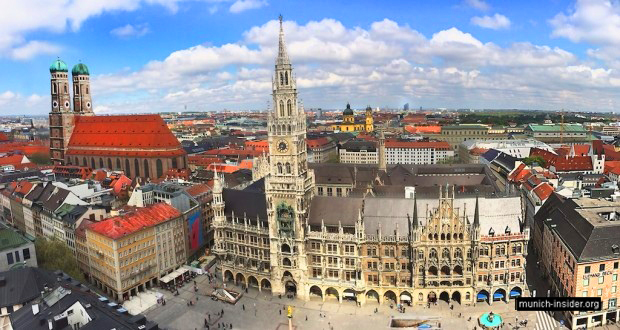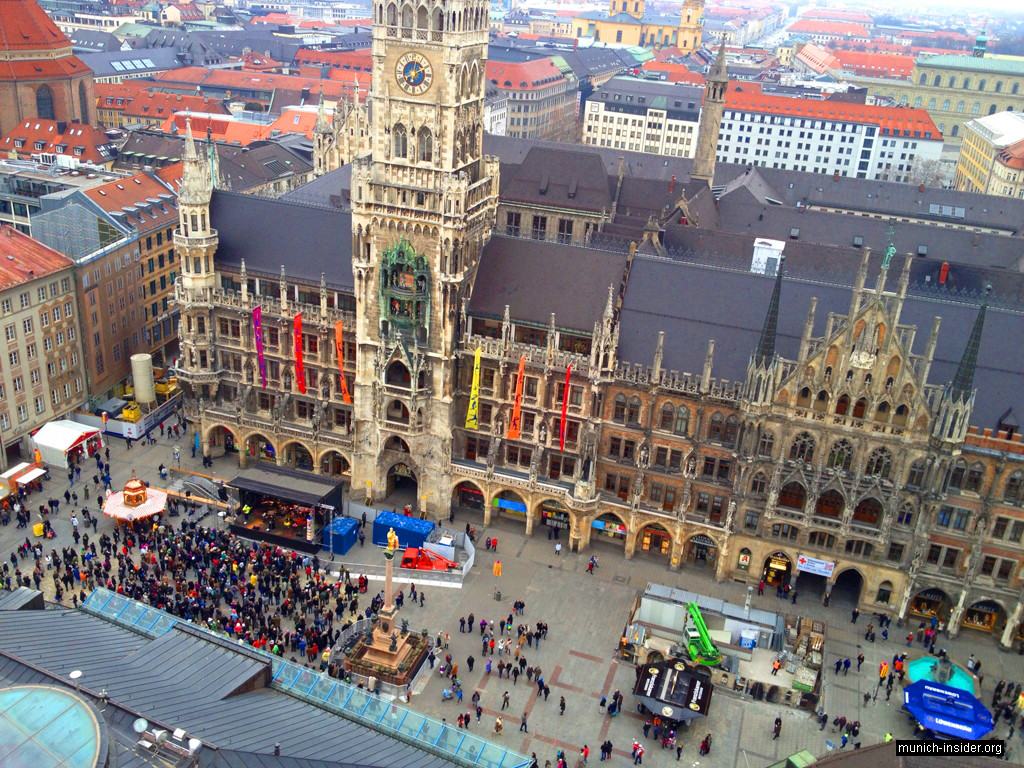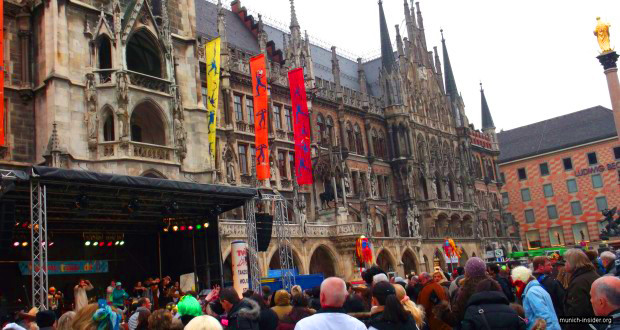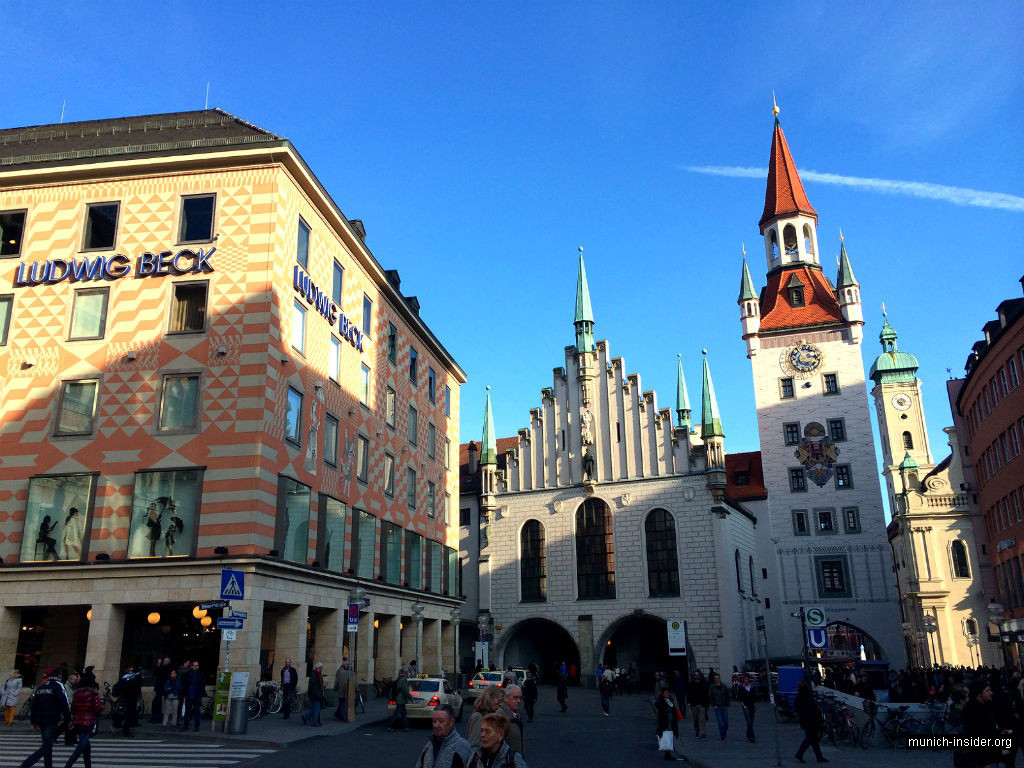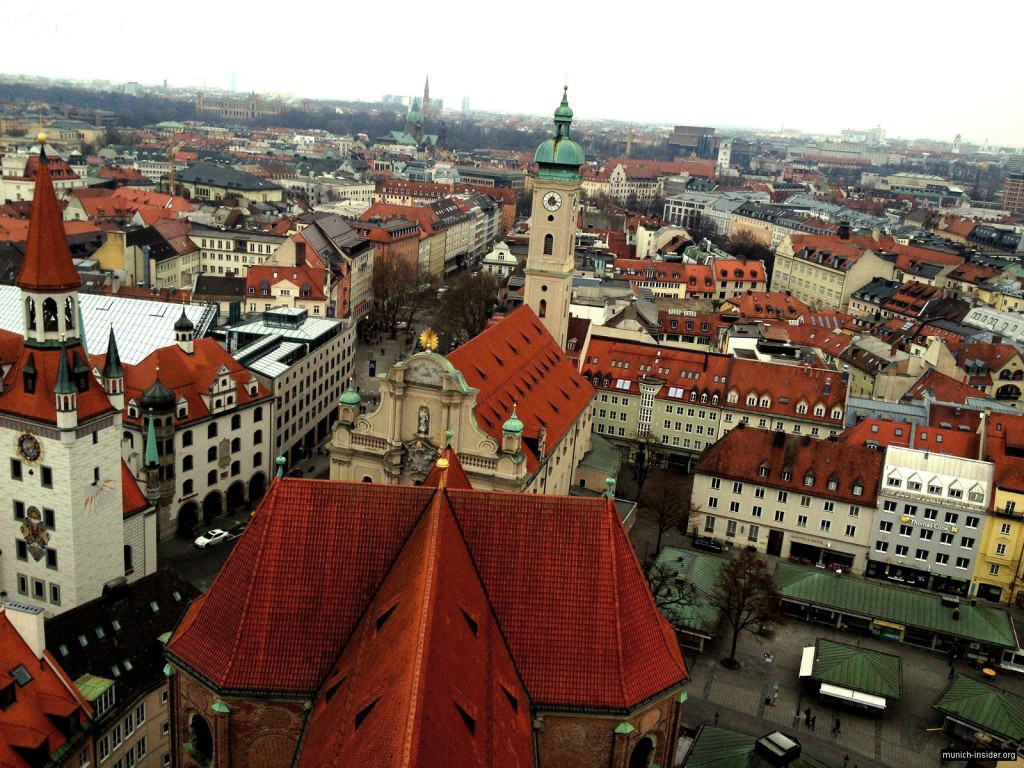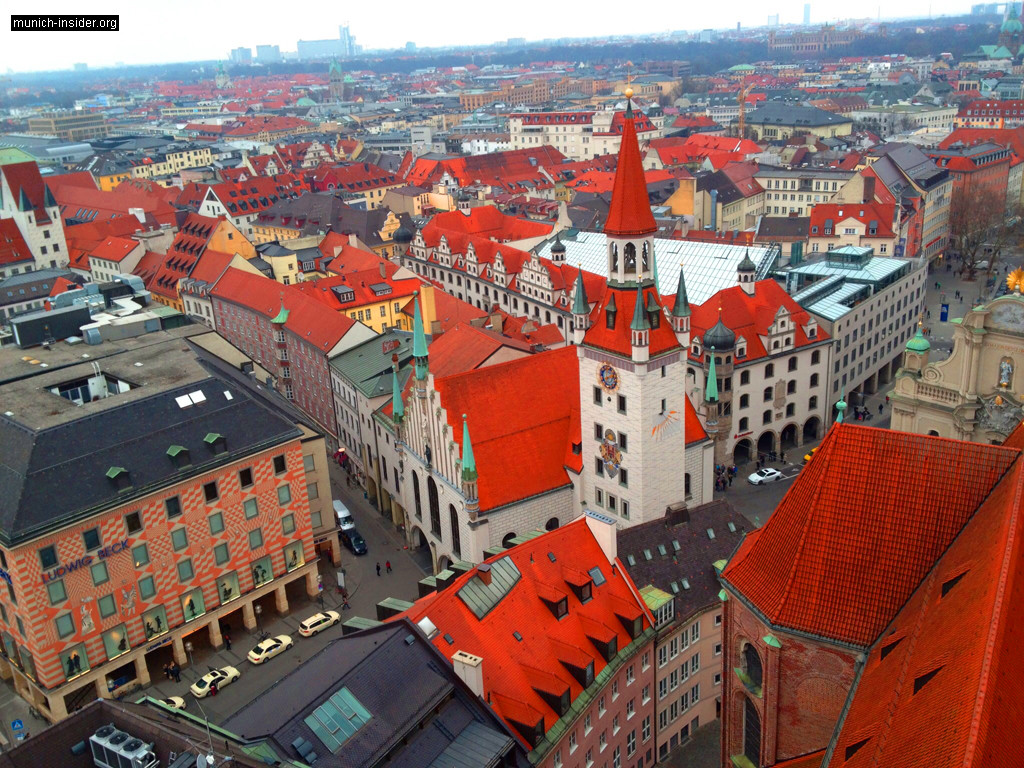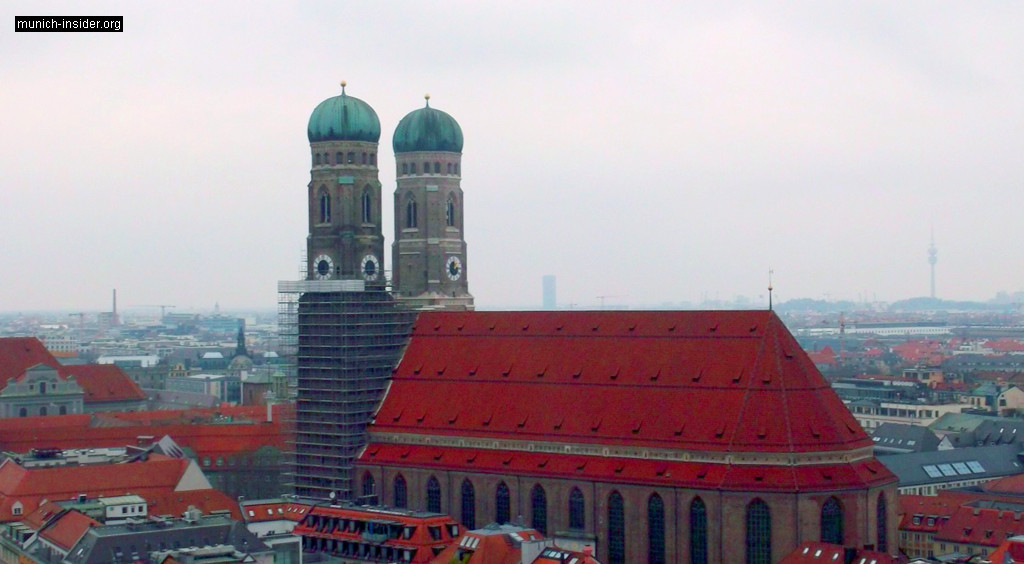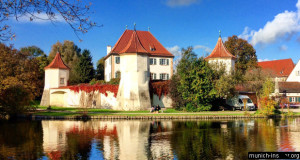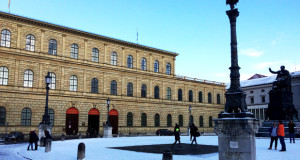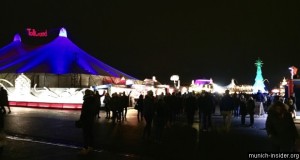Munich, the capital of Bavaria, is the third largest city in Germany. About 1.5 million people live here. There are many attractions and historical sites in the city and surrounding regions, and it is one of the most visited places in Europe. Munich is known for its breweries, unique churches and museums. There are numerous attractions within a radius of 100-150 km (62-93 mi) from the city, such as, picturesque lakes at the foothills of the Alps, fairytale castles of Bavarian kings, medieval towns, and more. If you come here for a few days, you can make quite a few trips in this extraordinary region. Of course, we would recommend starting from the city of Munich itself. To see as many attractions as possible in one day, one needs to plan the tours in advance. Here are a couple of suggestions based on our own experience.
Walk from Marienplatz to English Garden – the most important Munich sights in 3 hours
Nearest U-Bahn stations: Start – Marienplatz; End – Lehel, Odeonsplatz and Univesität (all three within a radius of 0.5 km (1700 ft) depending on where you end up in English Garden)
Duration: 3 hours.
Recommended time: 11 a.m. – 2 p.m.
Attractions: Marienplatz, Neues Rathaus (New Town Hall), churches – Peterskirche, Frauenkirche, Michaelskirche, Theatinerkirche; Stachus square, Odeonsplatz, Haus der Kunst (House of Arts), English Park
In any city I usually start exploring from the center. When I first came to Munich, I spent 3 hours walking through many of its iconic landmarks. The Old Town is rather small, so walking there is not very tiring and one can really see everything up and close.
I began from Marienplatz, the main central square in the city. Looking at the gorgeous Neues Rathaus, I thought: wow, they knew how to build elegantly and in a big way in the old times. However, it turns out that the building is actually not that old, it was built a little more than a century ago. The most interesting thing in it is Glockenspiel – the tower clock with chimes and moving figurines, which give performances at certain times of the day. I arrived just in time for the 11 a.m. performance, but in the summer there are also Glockenspiel plays at noon and 5 p.m. The figures come out of the windows, dance and play a short show. It is very interesting to watch.
While on Marienplatz, one has an opportunity to have a bird’s eye view of the Old Town. To do this, one has to be rather fit to climb up the numerous stairs in the tower of Peterskirche. The spiral staircase, an attraction in itself, is narrow and at least 15-story high. I was at the beginning of my walk and still felt strong enough. So, in a few minutes I was on the observation deck of the tower. The view from there was amazing. What I find the most interesting in German old houses are the roofs. They are all different in material, shape and color: tiles, shingles, metal, peaked, spherical, red, green and more. It is impossible to list all the variations. Of course, all this beauty is better seen from above. After admiring the city for about 15 minutes I went downstairs.
Just a short walk from Neues Rathaus, to the left (north-west) of it, you will find the symbol and perhaps the main Munich’s attraction – Frauenkirche. I have already been in numerous European churches and, honestly, am getting somewhat tired of them. However, I’ve heard a legend that there is a footprint, supposedly left by the devil, at the entrance to this church. Legends, especially the devilish ones, always attract me. Allegedly the devil stomped here, dissatisfied with something, and the trace remained. The imprint of the devil’s foot is quite elegant, embedded in a diamond-shaped marble tile. The church interior has a surprisingly modest appearance, but from the outside the building looks impressive. The two major towers are capped by spherical roofs with short spikes. At 99 meters (325 feet) it is believed to be the tallest building in Munich and it is forbidden to construct buildings taller than this. Actually, this is true only for the Old Town and there are high-rise office towers of large corporations away from the city center. Incidentally, the Munich TV tower (Olympiaturm) in the Olympic Park is 291 m (955 feet) high.
From Frauenkirche, it was nice to walk through the Old Town’s pedestrian zone. Kaufingerstrasse is the main shopping street. It is always crowded and noisy; street musicians play here and all sorts of snacks are sold. I, too, could not resist and fell for a typical German street snack – a grilled pork sausage (bratwurst) with mustard in a bun. Simple and delicious. It was easier to walk after the snack. One block to the right of my path a magnificent facade of the Michaelskirche church appeared. Ludwig II of Bavaria is buried in this church. He was the “fairytale” king who built the famous castles near Munich in the 19th century. I decided not to visit the king’s grave and continued on. In a few minutes I reached Karlsplatz. This plaza, which the locals call Stachus, is perhaps the most beautiful square in Munich. The semi-circular plaza is surrounded by architecturally exquisite buildings. There is a fountain in the middle, which is a popular place for people to hang out. I stopped here for a while and just enjoyed the area.
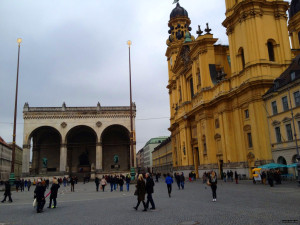 While Karlsplatz is the most beautiful square in Munich, Odeonsplatz, located a 10-minute walk from it, is likely the most grandiose. This square’s architecture and colors are in the Roman style. No wonder the Germans like to hold parades and public processions here. By the way, this is where the Nazis clashed with police during the infamous Beer Hall Putsch. The adornment of the area is the Theatinerkirche church. Its domes are typical Bavarian, or perhaps Austrian; I found them resembling helmets of Austrian and German troops in World War I. The church’s interior is all white. Many Bavarian kings were buried there as well. I would call this church too pompous.
While Karlsplatz is the most beautiful square in Munich, Odeonsplatz, located a 10-minute walk from it, is likely the most grandiose. This square’s architecture and colors are in the Roman style. No wonder the Germans like to hold parades and public processions here. By the way, this is where the Nazis clashed with police during the infamous Beer Hall Putsch. The adornment of the area is the Theatinerkirche church. Its domes are typical Bavarian, or perhaps Austrian; I found them resembling helmets of Austrian and German troops in World War I. The church’s interior is all white. Many Bavarian kings were buried there as well. I would call this church too pompous.
From Odeonsplatz, I walked under the arch and found myself in a small park, Hofgarten. I passed a stone throw away from the Munich Residenz. This was the main residence of Bavarian Kings. I did not have time to visit this palace during this walk; will have to return here some other time. At the far end of Hofgarten, there is a posh building of the Bavarian State Chancellery. It is the seat of provincial government, which was of little interest to me. However, after crossing the park diagonally, I got a view of another building, which I had heard something about previously. This building of bulky shapes and gloomy colors is called the Haus der Kunst (House of Arts). It was built on the orders of Hitler for exhibitions promoting pure Aryan arts. During the Nazi era, the “Degenerate Art” exhibition also took place here; it was intended to exhibit and publically condemn many masterpieces of the world art, including Impressionist paintings. Nowadays, the Haus der Kunst is a place for permanent art exhibitions. I suspect that the present popularity of this place is mostly due to the fact that the building also houses Goldene Bar with the glamorous P1 disco which attracts many celebrities. I’ve heard that common people cannot get there for any price. I searched for the bar entrance and was surprised to find it at the back of the building. It had a small discreet sign, which looked as if it were hand-written. Apparently the rich and famous here do not like to show themselves off.
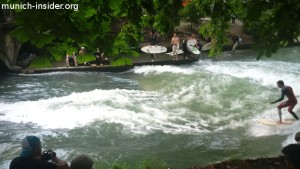 The Haus der Kunst is located at the south edge of English Garden (Englischer Garten), which is the favorite pastime destination of Munich residents. The park is very large in area, but its southern part is located at the inner city edge. In this park one can completely disconnect from the bustle of the city without actually leaving the city. I have heard that nude sunbathing is allowed on some meadows. I cannot confirm if that’s true or not – it was rather chilly in March when I visited the Garden. However, I did see surfers and their performances were really cool. One of the streams in the park near the Haus der Kunst has a so-called “standing wave” which attracts surfing virtuosos from all over the world, even from Australia. I never thought that one could see such a show in the middle of Europe. The stream is not very big, but has become one of the most entertaining attractions in Munich. For 20 minutes I was glued to this spectacle. I would have watched it even longer, but my friends were waiting for me for dinner.
The Haus der Kunst is located at the south edge of English Garden (Englischer Garten), which is the favorite pastime destination of Munich residents. The park is very large in area, but its southern part is located at the inner city edge. In this park one can completely disconnect from the bustle of the city without actually leaving the city. I have heard that nude sunbathing is allowed on some meadows. I cannot confirm if that’s true or not – it was rather chilly in March when I visited the Garden. However, I did see surfers and their performances were really cool. One of the streams in the park near the Haus der Kunst has a so-called “standing wave” which attracts surfing virtuosos from all over the world, even from Australia. I never thought that one could see such a show in the middle of Europe. The stream is not very big, but has become one of the most entertaining attractions in Munich. For 20 minutes I was glued to this spectacle. I would have watched it even longer, but my friends were waiting for me for dinner.
Walk from Sendlinger Tor to Isartor past New Synagogue and Old Market
Start: U-Bahn station – Sendlinger Tor; End: S-Bahn station – Isartor or U-Bahn station – Fraunhoferstrasse (near Gärtnerplatz)
Duration: 3 hours
Recommended time: 11 am – 2 pm
Attractions: city gates – Sendlinger Tor and Isartor, Asamkirche church, Munich Synagogue, city squares – Viktalienmarkt and Gärtnerplatz
In the Middle Ages, the city of Munich was within the boundaries of today’s Old Town. As any medieval city it was walled and to get in and out one had to go through one of the city’s gates. So, we decided to take a stroll through the Old Town from one gate to another. We chose a route from Sendlinger Tor to Isartor, that is, from the south-west to the south-east. It is the southern part of the Old Town, and we find it more picturesque than perhaps more grandiose northern part.
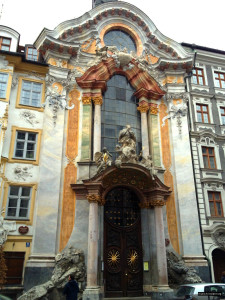 The first attraction on our route was the Asamkirche church located next to Sendlinger Tor on Sendlingerstrasse. It is one of the most elegant and magnificent buildings in Munich. The church’s facade is built into a row of other houses; however, it is so beautiful that you will not pass it by without stopping. The Baroque style is just spectacular. The interior is also opulent. There are several confessionals near the entrance and a small but elegant organ upstairs. We always like to listen to organ music in churches. This time we were especially lucky – they played Bach. The pleasant impression of this church was amplified by the divine music.
The first attraction on our route was the Asamkirche church located next to Sendlinger Tor on Sendlingerstrasse. It is one of the most elegant and magnificent buildings in Munich. The church’s facade is built into a row of other houses; however, it is so beautiful that you will not pass it by without stopping. The Baroque style is just spectacular. The interior is also opulent. There are several confessionals near the entrance and a small but elegant organ upstairs. We always like to listen to organ music in churches. This time we were especially lucky – they played Bach. The pleasant impression of this church was amplified by the divine music.
 After Asamkirche we headed further towards Viktualienmarkt, one of the main shopping areas of the city. On the way, an unusual building standing out among the others attracted our attention. This was the Munich synagogue (Ohel Jacob). One could notice right away that it was newly built, though stylized to resemble something old. Indeed, this new synagogue was built about a decade ago on the site of the old one destroyed by the Nazis. The rectangular base constructed of large stones somewhat resembles Jerusalem structures, such as the Wailing Wall. The glass cube atop of the base symbolizes a hut or a tent of the ancient Israelites. We found this architectural solution to be very original.
After Asamkirche we headed further towards Viktualienmarkt, one of the main shopping areas of the city. On the way, an unusual building standing out among the others attracted our attention. This was the Munich synagogue (Ohel Jacob). One could notice right away that it was newly built, though stylized to resemble something old. Indeed, this new synagogue was built about a decade ago on the site of the old one destroyed by the Nazis. The rectangular base constructed of large stones somewhat resembles Jerusalem structures, such as the Wailing Wall. The glass cube atop of the base symbolizes a hut or a tent of the ancient Israelites. We found this architectural solution to be very original.
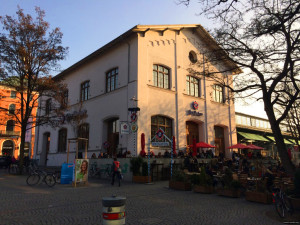 We moved on and soon found ourselves behind Altes Rathaus (Old Town Hall) on Viktualienmarkt. Its architecture is light, bright and diverse. The square is surrounded by elegant buildings housing hotels, restaurants and boutiques. We’ve been told that this square is very popular and becomes really overcrowded during holidays, such as Christmas, carnivals, etc. We made a short stop here for beer in one of the most famous Munich breweries – Hacker-Pschorr. The place and its atmosphere were so cozy that we did not want to leave. However, after having this nice break we had to move on.
We moved on and soon found ourselves behind Altes Rathaus (Old Town Hall) on Viktualienmarkt. Its architecture is light, bright and diverse. The square is surrounded by elegant buildings housing hotels, restaurants and boutiques. We’ve been told that this square is very popular and becomes really overcrowded during holidays, such as Christmas, carnivals, etc. We made a short stop here for beer in one of the most famous Munich breweries – Hacker-Pschorr. The place and its atmosphere were so cozy that we did not want to leave. However, after having this nice break we had to move on.
 Having crossed the Viktualienmarkt square diagonally, we turned onto Frauenstrasse and reached Isartor in a few minutes. It is a very well-preserved medieval gate. Actually, little remains in Munich from the Middle Ages. As its name says, Isartor (which means the Isar gate) once served as the entrance to the city from the Isar river. Nowadays, Isartor is in the middle of a lovely square, and a short, but wide street leads from it to the bridge over Isar, Ludwigsbrücke. It is evident that the medieval Isartor structure has been restored many times; one might find that it was probably “over-renovated” to such extent that it now has a brand-new appearance.
Having crossed the Viktualienmarkt square diagonally, we turned onto Frauenstrasse and reached Isartor in a few minutes. It is a very well-preserved medieval gate. Actually, little remains in Munich from the Middle Ages. As its name says, Isartor (which means the Isar gate) once served as the entrance to the city from the Isar river. Nowadays, Isartor is in the middle of a lovely square, and a short, but wide street leads from it to the bridge over Isar, Ludwigsbrücke. It is evident that the medieval Isartor structure has been restored many times; one might find that it was probably “over-renovated” to such extent that it now has a brand-new appearance.
From Isartor, we walked a little towards Gärtnerplatz. This area is called Isarvorstadt (Isar suburb); it is one of the oldest and most expensive districts in Munich. Many German celebrities live here – actors, athletes, entertainers and others. Munich’s golden youth also like to hang out here, cafes and clubs on Gärtnerplatz being especially popular. Gärtnerplatz is a beautiful round plaza at the intersection of six streets, with flowerbeds and a fountain in the center. One of the buildings surrounding the plaza is a theater with a magnificent facade. We wandered around a bit in the side streets surrounding Gärtnerplatz looking for a cafe or restaurant for the coming evening.
Walk along Maximilianstrasse
Duration: from 30 minutes (just to stroll along the street, less than 2 km or 1.2 mi) to several hours (depending on your interests)
Attractions: Maximilianeum – Landtag (Bavarian Parliament), Maximiliansbrücke, Maxmonument, GOP Varieté-Theater, Regierung von Oberbayern, Maximilianstrasse shopping quarter, Vier Jahreszeiten Kempinsky hotel, Spatenhaus restaurant
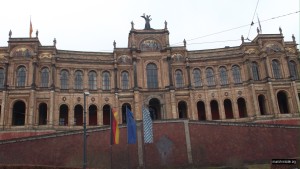 The Old Town begins on the west side of the bridge. Almost immediately we came to an impressive sizes statue. This is Maxmonument erected in honor of King Maximilian II of Bavaria. In general, everything in this part of the city is connected with the name of Maximilian. Maximilian II was the 19th century Bavarian King who began the construction of this street. Bavarians respect their own, especially kings. Maximilian II was distinguished by a certain liberalism, and he contributed to the spread of education and culture in his kingdom. In foreign policy he was against the unification of the German States, so in a modern political lexicon he might be called a separatist.
The Old Town begins on the west side of the bridge. Almost immediately we came to an impressive sizes statue. This is Maxmonument erected in honor of King Maximilian II of Bavaria. In general, everything in this part of the city is connected with the name of Maximilian. Maximilian II was the 19th century Bavarian King who began the construction of this street. Bavarians respect their own, especially kings. Maximilian II was distinguished by a certain liberalism, and he contributed to the spread of education and culture in his kingdom. In foreign policy he was against the unification of the German States, so in a modern political lexicon he might be called a separatist.
From the Maxmonument the street widens, forming a small square of boulevard. The main architectural attraction here is the building of the Government of Upper Bavaria (Regierung von Oberbayern). The façade of this 19th century palace is made of terracotta stone; its soft tones are in harmony with other architectural ensembles of Maximilianstrasse. Sometimes this architectural style is called Maximilianstyle, emphasizing the character of the most fashionable street in Munich.
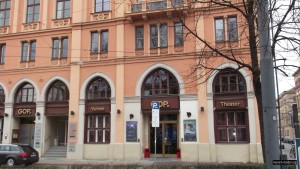 The GOP (Georgspalast) variety theater is also in this area. One can spend a pleasant evening here. The variety show is different from the French shows in similar establishments, but is also interesting in its own way. Usually the show includes singers, acrobats and dancers. Delicious dinner with drinks is served at the tables. IMHO it is worth visiting.
The GOP (Georgspalast) variety theater is also in this area. One can spend a pleasant evening here. The variety show is different from the French shows in similar establishments, but is also interesting in its own way. Usually the show includes singers, acrobats and dancers. Delicious dinner with drinks is served at the tables. IMHO it is worth visiting.
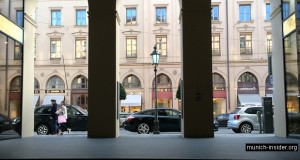 The next blocks of Maximilianstrasse is a real paradise for lovers of exclusive and expensive shopping. Boutiques of famous world brands are represented here in all the splendor of the assortment and prices. The fashionable character of this quarter is highlighted by the façade of the five-star Hotel Vier Jahreszeiten Kempinsky.
The next blocks of Maximilianstrasse is a real paradise for lovers of exclusive and expensive shopping. Boutiques of famous world brands are represented here in all the splendor of the assortment and prices. The fashionable character of this quarter is highlighted by the façade of the five-star Hotel Vier Jahreszeiten Kempinsky.
Our walk along Maximilianstrasse ends on Max-Joseph-Platz, one of the central squares in the Old Town. The main attraction here is the Bavarian Opera House. It was built in the neo-Greek style. Across the street from the Opera is the famous Spatenhaus restaurant. This is a good place to finish our walk and stay for a pleasant evening in a good company.
Share on:
 Munich Insider Tips and advice from Munich residents for self-guided tours and trips
Munich Insider Tips and advice from Munich residents for self-guided tours and trips
